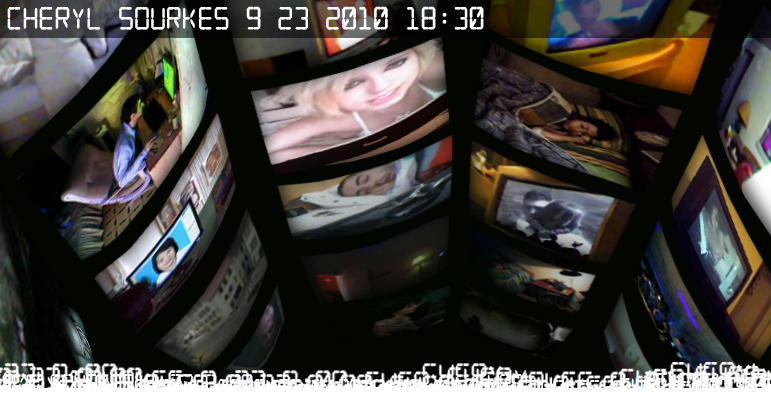
Thursday, September 23, 2010, 6:30 – 9:00 p.m.
4001 Berri, Suite 201
Free admission for members / $5.00 for non-members
Hors d’œuvres and drinks will be served
Over the past decade, webcams have transformed from an obscure sideline of computer hardware to standard equipment, producing social and cultural developments with help from the Internet.
Toronto lens-based digital artist Cheryl Sourkes’ current artistic practice (re)presents imagery generated by webcams. During her presentation, Sourkes will offer examples of her webcam work, from its inception during her residency at Studio XX in 2000 when she developed Field Guide to Artificial Life on the Web through to the Facebook albums Sourkes is currently generating. Sourkes will also entertain some of the technical and theoretical considerations raised by webcams.
* Please be advised that visual material will include some explicit sexual content.
Cheryl Sourkes grew up in Montreal and studied psychology and biology at McGill University. Sourkes moved to Vancouver in 1967 where she became involved with Intermedia, a Dadaist artist collective. Sourkes has lived and worked in Toronto since 1993. Selections of her work Public Camera, accompanied by a catalogue essay by Cheryl Simon, recently toured to The National Gallery of Canada. Sourkes currently sits on the board of Art Metropole.
www.cherylsourkes.com
Cheryl Sourkes: Artist Statement
“Webcams create an ongoing record of the contemporary world. They do this in spite of an absence of Cartier-Bresson type ‘decisive moments’. Webcams reveal an unadorned and unheroic quotidian reality that more nearly mirrors ‘everyday life’ than does any other visual modality. Beach cams, pet cams, ski cams, traffic cams and tourist cams stream updated images whether it is day or night, and whether or not anything at all is happening in front of them. In addition, in the wake of Jennicam, vast numbers of people have established home cams, which they have focused on their personal digs or, more than likely, on their actual person. These cameras provide access to formerly completely inaccessible or else totally neglected sites and subjects.
My art practice draws on this webcam-o-sphere for inspiration and for material. I reformat and recontextualize webcam-generated imagery and bring it forward for consideration. For instance, I regularly publish new images on my Facebook page. I have created albums of windows, night, animals, beds, people at home, talking on telephones and smoking. I really enjoy the immediacy of this process. I also really enjoy my Facebook friends’ response. With hindsight it appears I am willy nilly creating a profile of the cultural zeitgeist.
I am mesmerized by the sheer largess, as well as by the theoretical considerations, posed by the existence of the webcam-o-sphere. On the technical level, my production investigates some of the possibilities of the 72 dpi image. Typically this low-resolution image signals immediacy and urgency. It embodies a visual vocabulary that references the cool of wireless communication. Webcam images may be seen positioned between sharp and soft focus, between still and moving image, and between intentional and accidental scenario.
By presenting physical space in virtual space, webcams participate in a mixed reality that vexes the traditional boundary between real and virtual as well as between public and private domains. Although they are primarily driven by desire, webcams can be read as primary cultural documents. Perhaps contrary to expectation, government surveillance plays a lesser role in the world of webcams than does self-surveillance. Webcams along with cell phones and other wireless mobile devices operate in an ever-expanding zone of distributed consciousness. So, on the level of technique, as well as on the level of content, images generated by webcams enact noteworthy paradigm shifts in visual culture.”